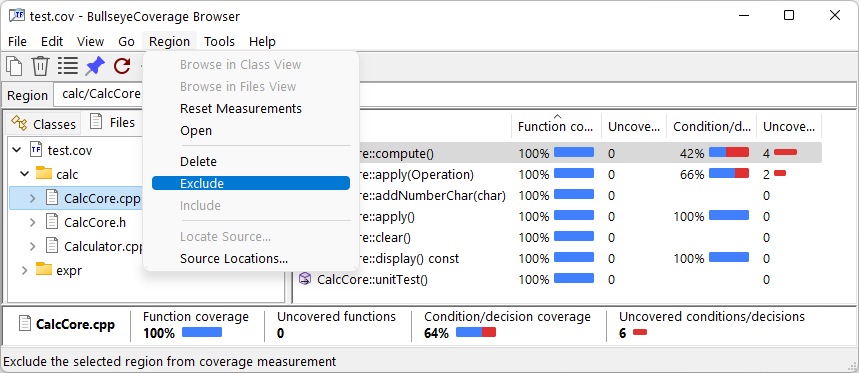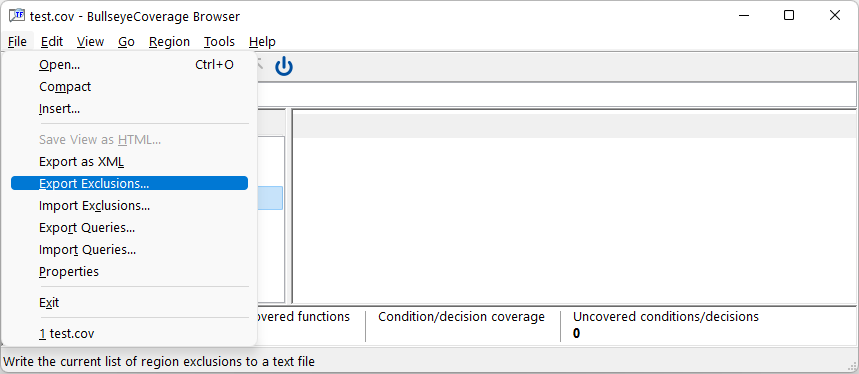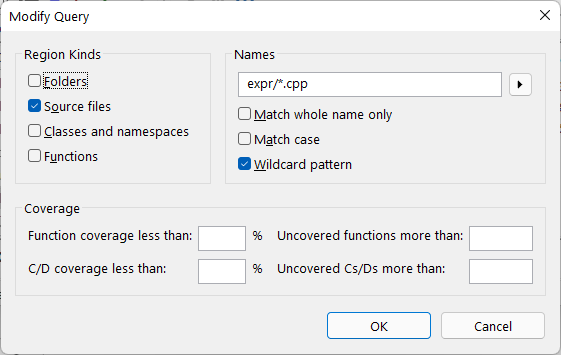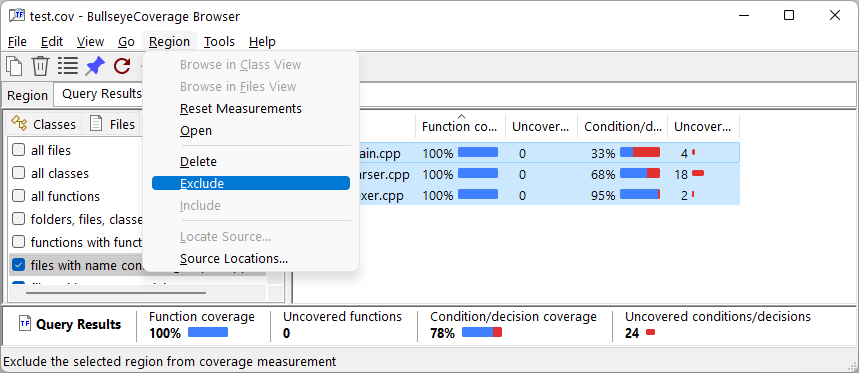BullseyeCoverage
You can exclude header files external to your project with the Microsoft C++
/external options
or the GCC/Clang
-isystem option.
These options specify directories containing headers that are maintained and tested by someone else and
cause the compiler to suppress warnings in those headers.
BullseyeCoverage recognizes these options and automatically excludes the code in those headers,
unless you use the covc --no-autox option.
For example,
use the Microsoft C++ compiler option /external:I rather than /I to exclude a directory.
cl /Ic:\external_dir ← change this cl /external:I c:\external_dir /external:W0 ← to this
With Microsoft C++,
you can specify external include directories with the EXTERNAL_INCLUDE environment variable.
For example,
INCLUDE= C:/Program Files/Microsoft Visual Studio/2022/Professional/VC/Tools/MSVC/14.44.35207/include ← change this EXTERNAL_INCLUDE= C:/Program Files/Microsoft Visual Studio/2022/Professional/VC/Tools/MSVC/14.44.35207/include ← to this
With GCC,
use -isystem instead of -I to exclude a directory.
g++ -I/external_dir ← change this g++ -isystem /external_dir ← to this
After building your code, you can easily exclude regions from both
the reported results and from subsequent builds using commands in the
Coverage Browser
menu Region.
Select a region, then choose either
Region Exclude or Region Include.

When you have the exclusions you want,
use the menu command File Export Exclusions to save the selections separately from the coverage file.

You can apply the saved selections to a new coverage file using covselect --import.
It is recommended to apply exclusions with covselect after your build finishes rather than at the beginning.
This allows adjusting the exclusions without having to rebuild.
rm -f $COVFILE cov01 -1 (perform build) cov01 -0 covselect --import BullseyeCoverageExclusions
You can easily exclude filenames matching a wildcard pattern after they have already been instrumented. In subsequent builds, BullseyeCoverage does not instrument excluded regions.
View Queries.
View Query New Query.
Source Files only.
Wildcard pattern and enter your wildcard pattern in the Names text box.
OK.

Region Exclude.

You can exclude files from all directories
using the covselect action -a/--add with the ** wildcard as shown below.
Using a Unix-like shell such as bash:
covselect -a '!**/pattern' # Need quotes with Unix-like shell
Using Windows shell:
covselect -a !**/pattern
For example, the command below excludes all files named *_test*.cpp in any directory.
covselect -a '!**/*_test*.cpp'
Verify the settings with action -l/--list.
$ covselect -l -q exclude source **/*_test*.cpp
You can prevent BullseyeCoverage from instrumenting specific statements
using #pragma directives.
The directive #pragma BullseyeCoverage off prevents instrumentation of code that follows, while
code following #pragma BullseyeCoverage on is instrumented.
For example,
switch (n) {
case 1: one++; break;
case 2: two++; break;
case 3: three++; break;
#if _BullseyeCoverage
#pragma BullseyeCoverage off
#endif
default: abort();
#if _BullseyeCoverage
#pragma BullseyeCoverage on
#endif
}
Use the directive commands save and restore to preserve the effect of encompassing directives.
For example:
switch (n) {
case 1: one++; break;
case 2: two++; break;
case 3: three++; break;
#if _BullseyeCoverage
#pragma BullseyeCoverage save off
#endif
default: abort();
#if _BullseyeCoverage
#pragma BullseyeCoverage restore
#endif
}
If your compiler supports _Pragma,
you can define macros for excluding code more concisely.
#if _BullseyeCoverage
#define BullseyeCoverageSaveOff _Pragma("BullseyeCoverage save off")
#define BullseyeCoverageRestore _Pragma("BullseyeCoverage restore")
#else
#define BullseyeCoverageSaveOff
#define BullseyeCoverageRestore
#endif
switch (n) {
case 1: one++; break;
case 2: two++; break;
case 3: three++; break;
BullseyeCoverageSaveOff
default: abort();
BullseyeCoverageRestore
}
The ignore directive is appropriate for excluding short sections of code.
assert(p != NULL); #pragma BullseyeCoverage ignore if (p != NULL) p->function(); #pragma BullseyeCoverage ignore:3 void placeHolder1() { } void noRealCodeHere() { } void deadCode() { }
The ignore directive provides a terse method for excluding default labels.
switch (n) {
case 1: one++; break;
case 2: two++; break;
case 3: three++; break;
#pragma BullseyeCoverage ignore
default: abort();
}
Rather than excluding an impossible switch default,
you may wish to replace one of your case labels with default,
and assert the intended matching value.
| Four branches | Three branches |
switch (n) {
case 1: one++; break;
case 2: two++; break;
case 3: three++; break;
default: assert(false); break;
}
|
switch (n) {
case 1: one++; break;
case 2: two++; break;
default: assert(n == 3); three++; break;
}
|
Updated: 11 Aug 2025
Copyright © Bullseye Testing Technology. All Rights Reserved.